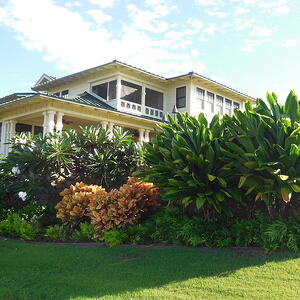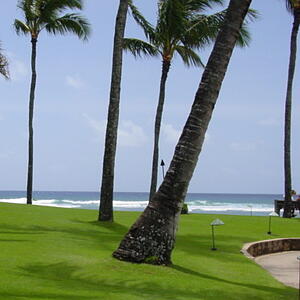 A green lawn is actually “green,” so it’s worth the effort and investment to keep landscape healthy. For one, lawns trap more than 12 million tons of dust and dirt annually, according to The Lawn Institute. And, turfgrass acts like an air conditioner for surrounding areas because it’s much cooler than asphalt or cement. Grass filters rainwater, provides oxygen, and just looking at a green lawn can relieve stress.
A green lawn is actually “green,” so it’s worth the effort and investment to keep landscape healthy. For one, lawns trap more than 12 million tons of dust and dirt annually, according to The Lawn Institute. And, turfgrass acts like an air conditioner for surrounding areas because it’s much cooler than asphalt or cement. Grass filters rainwater, provides oxygen, and just looking at a green lawn can relieve stress.
Cultural practices are the sustainable way to care for your lawn and keep your lawn green, in more ways than one. A healthy lawn will require less intervention.
April is National Lawn Care Month, which makes this the perfect time to celebrate everything our Kauai turfgrass does for us! Because our lawns give us so much, here are five ways you can give back to the grass and keep it growing strong yearlong.
Start with a Soil Test
A soil test is like an annual physical for your lawn. It uncovers information about your soil that you can’t see, and its results will help you properly care for your lawn. At-home test kits are available, or you can send a soil sample to a reliable lab, such as a university extension.
The soil test will tell you: soil pH level; available nutrients and micronutrients; soluble salts and sodium (lower is better); organic matter; capacity for holding nutrients (higher is better); and recommendations for amending the soil.
Why does all this matter? Soil can only provide a great growing environment for grass if the pH is correct. Once you know your soil’s status, you can customize a lawn care program and you’ll avoid using unnecessary chemicals.
Right Grass, Right Place
A twist on the old plant rule of thumb, you want to plant the right type of grass for your property. Key factors to consider are soil content, sun exposure and watering requirements.
If you start with the proper turfgrass for your land, you’ll save water, resources (fertilizers and more), and labor (mowing).
Leave Clippings, Control Thatch
Forget the lawn bagger and leave grass clippings on the lawn. Mown grass is about 90 percent water, so clippings will begin decomposing almost immediately. (In other words, clippings will not cause thatch.) Clippings then return nutrients to the soil.
So, what’s thatch? That’s the dead grass and root tissue between the green grass and the soil surface. If thatch is ½ inch thick or more, it can block water, air and nutrients from reaching the roots. Thatch is also a nesting site for insects and disease. Thatch can be removed through aeration, vertical mowing or simply using a thatch rake.
Mind Your Mowing Technique

If grass is cut too short, it has to fight harder during drought times and is more likely to fall prey to weeds and disease. Tall grass has deeper roots, allowing the plants to access more nutrients and water from the soil. When mowing, only cut off a third of the turf stand at one time. Different grass types call for varying mowing heights.
A landscape professional can assess your turf type and ensure that proper mowing practices are in place. Another important point: Avoid mowing when turf is stressed or wet, which compromises its vigor and ability to naturally ward of invaders, from the basic dandelion to more difficult-to-treat pests.
Understand Fertilizer’s Essential Elements: N, P, K
When a fertilizer application is necessary to promote turf health and vigor, be sure you’re applying the proper formulation. Now for a chemistry lesson. Fertilizer is made up of three elements: Nitrogen (N), Phosphorus (P) and Potassium (K). Nitrogen “greens up” a lawn. It helps the plant metabolize and produce leaf growth. Phosphorus promotes root growth. Potassium protects turf during droughts and feeds the lawn over the long-term.
When choosing a fertilizer, always refer to the N-P-K rating and label. A professional landscape contractor can advise what formulation is best for your turf type and assure that minimal applications are made to sustain turf health. Cultural practices are the priority, but when a lawn needs a lift, safe use of fertilizers that are accurately applied, will benefit the lawn.
Call On The Professionals
Better yet, leave your turf care and fertilization to the pros!
There is a sustainable way to care for your Kauai commercial property’s lawn, and our lawn care professionals can help you create a plan to ensure plant health while reducing environmental impact.
Give us a call at 808-335-5887 to learn more, or email info@nkolansdcaping.com.










